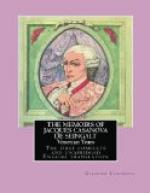In 1788 Casanova published the history of his famous flight from “The Leads”. An article on this book appeared in the German ‘Litteratur-Zeitung’, 29th June 1789: “As soon as the history was published and while it was exciting much interest among us and among our neighbors, it was seen that other attempts at flight from prisons would make their appearance. The subject in itself is captivating; all prisoners awake our compassion, particularly when they are enclosed in a severe prison and are possibly innocent . . . . The history with which we are concerned has all the appearances of truth; many Venetians have testified to it, and the principal character, M. Casanova, brother of the celebrated painter, actually lives at Dux in Bohemia where the Count Waldstein has established him as guardian of his important library.”
In July 1789 there was discovered, among the papers of the Bastille, the letter which Casanova wrote from Augsburg in May 1767 to Prince Charles of Courlande on the subject of fabricating gold. Carrel published this letter at once in the third volume of his ’Memoirs authentiques et historiques sur la Bastille’. Casanova kept a copy of this letter and includes it in the Memoirs.
In October 1789, Casanova wrote M. Opiz that he was writing to a professor of mathematics [M. Lagrange] at Paris, a long letter in Italian, on the duplication of the cube, which he wished to publish. In August 1790, Casanova published his ’Solution du Probleme Deliaque demontree and Deux corollaires a la duplication de hexadre’. On the subject of his pretended solution of this problem in speculative mathematics, Casanova engaged with M. Opiz in a heated technical discussion between the 16th September and 1st November 1790. Casanova sought vainly to convince Opiz of the correctness of his solution. Finally, M. Opiz, tired of the polemics, announced that he was leaving on a six-weeks tour of inspection and that he would not be able to occupy himself with the duplication of the cube for some time to come. On the 1st November, Casanova wished him a pleasant journey and advised him to guard against the cold because “health is the soul of life.”
In 1797, appeared the last book published during Casanova’s lifetime, a small work entitled: ’A Leonard Snetlage, docteur en droit de l’Universite de Goettingue, Jacques Casanova, docteur en droit de l’Universite de Padoue’. This was a careful criticism of the neologisms introduced into French by the Revolution. In reference to Casanova’s title of “Doctor,” researches by M. Favoro at the University of Padua had failed to establish this claim, although, in the Memoirs Casanova had written:
“I remained at Padua long enough to prepare myself for the Doctor’s degree, which I intended to take the following year.” With this devil of a man, it is always prudent to look twice before peremptorily questioning the truth of his statement. And in fact, the record of Casanova’s matriculation was discovered by Signor Bruno Brunelli.




